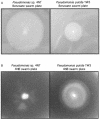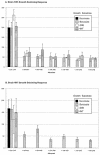Nitrobenzoates and aminobenzoates are chemoattractants for Pseudomonas strains
- PMID: 14711654
- PMCID: PMC321308
- DOI: 10.1128/AEM.70.1.285-292.2004
Nitrobenzoates and aminobenzoates are chemoattractants for Pseudomonas strains
Abstract
Three Pseudomonas strains were tested for the ability to sense and respond to nitrobenzoate and aminobenzoate isomers in chemotaxis assays. Pseudomonas putida PRS2000, a strain that grows on benzoate and 4-hydroxybenzoate by using the beta-ketoadipate pathway, has a well-characterized beta-ketoadipate-inducible chemotactic response to aromatic acids. PRS2000 was chemotactic to 3- and 4-nitrobenzoate and all three isomers of aminobenzoate when grown under conditions that induce the benzoate chemotactic response. P. putida TW3 and Pseudomonas sp. strain 4NT grow on 4-nitrotoluene and 4-nitrobenzoate by using the ortho (beta-ketoadipate) and meta pathways, respectively, to complete the degradation of protocatechuate derived from 4-nitrotoluene and 4-nitrobenzoate. However, based on results of catechol 1,2-dioxygenase and catechol 2,3-dioxygenase assays, both strains were found to use the beta-ketoadipate pathway for the degradation of benzoate. Both strains were chemotactic to benzoate, 3- and 4-nitrobenzoate, and all three aminobenzoate isomers after growth with benzoate but not succinate. Strain TW3 was chemotactic to the same set of aromatic compounds after growth with 4-nitrotoluene or 4-nitrobenzoate. In contrast, strain 4NT did not respond to any aromatic acids when grown with 4-nitrotoluene or 4-nitrobenzoate, apparently because these substrates are not metabolized to the inducer (beta-ketoadipate) of the chemotaxis system. The results suggest that strains TW3 and 4NT have a beta-ketoadipate-inducible chemotaxis system that responds to a wide range of aromatic acids and is quite similar to that present in PRS2000. The broad specificity of this chemotaxis system works as an advantage in strains TW3 and 4NT because it functions to detect diverse carbon sources, including 4-nitrobenzoate.
Figures




References
-
- Adler, J. 1973. A method for measuring chemotaxis and use of the method to determine optimum conditions for chemotaxis by Escherichia coli. J. Gen. Microbiol. 74:77-91. - PubMed
-
- Bhushan, B., S. K. Samanta, A. Chauhan, A. K. Chakraborti, and R. K. Jain. 2000. Chemotaxis and biodegradation of 3-methyl-4-nitrophenol by Ralstonia sp. SJ98. Biochem. Biophys. Res. Commun. 275:129-133. - PubMed
-
- Bradford, M. M. 1976. A rapid and sensitive method for the quantitation of microgram quantities of protein utilizing the principle of protein-dye binding. Anal. Biochem. 72:248-254. - PubMed
-
- Cerniglia, C. E., and C. C. Somerville. 1995. Reductive metabolism of nitroaromatic and nitropolycyclic aromatic hydrocarbons, p. 99-115. In J. C. Spain (ed.), Biodegradation of nitroaromatic compounds, vol. 49. Plenum Press, New York, N.Y.
-
- Chakrabarty, A. M. 1996. Microbial degradation of toxic chemicals: evolutionary insights and practical considerations. ASM News 62:130-137.
MeSH terms
Substances
LinkOut - more resources
Full Text Sources

